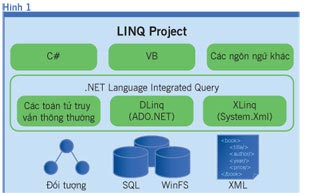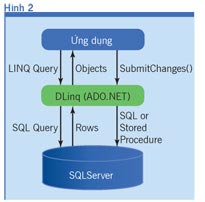LINQ clears query barriers
Unified programming solution, which provides the ability to query SQL syntax data directly in C # or VB.NET, applies to all types of data from objects to relational databases and XML.
Information or data processing is the most important task of any software and one of the main obstacles facing current developers is the difference between object-oriented programming language and language. Data query, the problem is more complex with the emergence of XML ( eXtensible Markup Language ).
Currently, the most common way to get data from database systems (SQL databases) is to use SQL ( Structure Query Language ). SQL has a very different syntax from popular programming languages such as C # and VB.NET, so programmers have to work hard to "mend" these two different entities together in each software project.
Another problem with SQL is that it is only used to query data in relational databases. If you want to access XML data or other forms (such as HTML pages, email .), the developer must use another query syntax (XPath / XQuery).
To reduce the burden of working on many different languages and improve programming productivity, Microsoft developed a data integration solution for the .NET Framework called LINQ (Language Integrated Query), which is an open library. for C # and Visual Basic .NET programming languages (which can be extended for other languages) provide the ability to directly query object data, databases, and XML. (Figure 1)
Query object data in memory
Data needs to be dumped into memory to process, but once separated from its original location, the query capability is very poor. You can easily query customer information associated with their order information from the SQL Server database but it is not easy to do the same with the information in memory. In a .NET environment, information (in memory) is often expressed in the form of objects and before LINQ, there is no way to concatenate objects or perform any query operations. LINQ is the solution to this problem.
For example, in SQL Server, we can query all records (records or rows) from the Customer table in the following way:
SELECT * FROM Customer
The return value is a "result set" that is similar to a data table, containing all the fields (fields) of the Customer table.
Using LINQ, we can do the same query with the C # or VB.NET commands, but only query the list of objects in memory instead of the table in the database. The following simple example uses "data source" as a string array, in VB.NET:
 Dim names As String () = {"Long", "Lan", "Qui", "Phung"}
Dim names As String () = {"Long", "Lan", "Qui", "Phung"}
Objects in the names array are named name.
ForEach name As String in names
'name.xxx
EndFor
Using LINQ syntax, we can query this "data source" similar to table queries with SQL.
Chọn tên từ tên trong tên
List the object (array) names here equivalent to the Customer table in the above SQL statement.
Because .NET is an object environment, everything is based on objects, attributes, and methods. So both the data source that we query as well as the returned result set are objects. So we need to declare the variable for the Select statement (or the result of the Select statement), for example:
Dim result As IEnumerable (Of String) = Select name From name in names
Similarly, in C #:
IEnumerable result = from name in names select names;
LINQ has enough query operators on object data similar to SQL on databases, such as order (order), condition (where) or join .
The feature to query objects in memory opens many interesting possibilities. For example, you can query all textboxes in a certain valid form, and link them to objects of a "union" with the query result set from the database or resource. XML data.
Querying "real" databases
Of course, data is not only in memory. There are two other important places that often contain data such as database systems (SQL Server) and XML documents (these "real" data are physically stored, have longer "live" time than "virtual" data in the set). mind). LINQ has two sets of API functions used to query these data sources: DLINQ uses query relational databases (SQL) and XLINQ uses hierarchical data queries (XML).
DLINQ
DLINQ is a special set of classes that allows displaying tables and data rows in the form of objects, so that LINQ can be used to query the database directly. (Figure 2)
DLINQ uses the DataContext object to open a connection to the database. Then use Table <> class to represent the data table, and with this object, we can use LINQ syntax to query.
The following example queries all customers with the company name starting with the "T" from the Northwind database of SQL Server, using the C # command syntax:
DataContext context =
new DataContext ("Initial Catalog = Northwind;" +
"Integrated Security = sspi");
Table customers =
context.GetTable ();
var result =
from c in customers
where c.CompanyName.StartsWith ("T")
select c;
XLINQ
What DLINQ does with databases, XLINQ does with XML.
Consider the following XML string:
PC World Vietnam
The Gioi Vi Tinh
.
XLINQ allows putting this XML string into XElement object to query with LINQ syntax.
XElement names = XElement.Parse (xmlString);
var result =
from n in names.Descendants ("customer")
where n.Descendants ("companyName")
.Value.StartsWith ("T")
select n.Descendants ("contactName"). Value;
This query returns a list of strings containing the contact name of all customers whose company name begins with the letter "T".
XLINQ also has other attractive features: XML creation. This is also done with XElement and other XLINQ objects.
 For example, consider the following XML data:
For example, consider the following XML data:
Kiểm TRA
We can create the above XML data with XLINQ objects.
XElement xml = new XElement ("root",
new XElement ("sub", "Test");
Console.Write (xml.ToString ());
More information about LINQ
The LINQ project has been pursued by Microsoft for many years and was officially announced at the Professional Developer Conference - PDC 2005 (September). Next, in May 2006, Microsoft released a trial LINQ library (http://msdn.microsoft.com/data/ref/linq/) that can be installed with Visual Studio 2005. Expected, LINQ will be integrated. in the next version of Visual Studio codenamed "Orcas" ( Object-Relational Component Architecture ).
One of the key players in the LINQ project is the chief architect of the C # language and the author of Turbo Pascal and Delphi (language with strong data processing capabilities): Anders Hejlsberg (refer joined Microsoft since 1996).
Phuong Uyen
You should read it
- Action Query in Action 2016
- Covered Query in MongoDB
- Options to create data queries in Access 2016
- The multiple-choice question set has an answer to Query P1
- MS Access 2003 - Lesson 22: Using Query Wizards
- Why use Microsoft Power Query for Excel
- MS Access 2003 - Lesson 21: Chapter 6: Using Query to check data
- Multiple choice questions have a Query option
May be interested
- The reg query command in Windows
 the reg query command helps return the next list of subkeys and entries ...
the reg query command helps return the next list of subkeys and entries ... - Query command in Windows
 (applies to windows server (semi-annual channel), windows server 2016, windows server 2012 r2, windows server 2012)
(applies to windows server (semi-annual channel), windows server 2016, windows server 2012 r2, windows server 2012) - Alternate Criteria in Access 2016
 in addition to the uses of the tipsmake.com query introduced in the previous lessons, you can also view data and records that meet two or more conditions using the alternative criteria.
in addition to the uses of the tipsmake.com query introduced in the previous lessons, you can also view data and records that meet two or more conditions using the alternative criteria. - 5 best SQL query optimization software to speed up MySQL
 the sql query optimizer analyzes many options for a given query, estimates the cost of each of these options, and finally, selects the lowest cost option.
the sql query optimizer analyzes many options for a given query, estimates the cost of each of these options, and finally, selects the lowest cost option. - Subquery - SUBQUERY in SQL
 subquery is a query inside another sql query and is embedded in the where clause.
subquery is a query inside another sql query and is embedded in the where clause. - Options to create data queries in Access 2016
 in this article, we will learn how to modify and sort queries in query design view, as well as how to use totals functions to create queries that can compute data. you will also learn more about other query options in access 2016.
in this article, we will learn how to modify and sort queries in query design view, as well as how to use totals functions to create queries that can compute data. you will also learn more about other query options in access 2016. - MS Access 2003 - Lesson 22: Using Query Wizards
 access includes 4 different types of wizard queries, and only one where you can see all of those query types. select query from the insert menu, access displays the new query dialog box as shown in figure 1.
access includes 4 different types of wizard queries, and only one where you can see all of those query types. select query from the insert menu, access displays the new query dialog box as shown in figure 1. - The quser (query user) command in Windows
 (applies to windows server (semi-annual channel), windows server 2016, windows server 2012 r2, windows server 2012)
(applies to windows server (semi-annual channel), windows server 2016, windows server 2012 r2, windows server 2012) - Qprocess (query process) command in Windows
 (applies to windows server (semi-annual channel), windows server 2016, windows server 2012 r2, windows server 2012)
(applies to windows server (semi-annual channel), windows server 2016, windows server 2012 r2, windows server 2012) - How to Check the Query Performance in an SQL Server
 this wikihow teaches you how to to use the sql server query store to monitor the performance of your database queries. open the sql server management studio. you can use the query store feature of sql server to monitor your database for...
this wikihow teaches you how to to use the sql server query store to monitor the performance of your database queries. open the sql server management studio. you can use the query store feature of sql server to monitor your database for...










 Protect yourself against the new Internet Explorer VML vulnerability
Protect yourself against the new Internet Explorer VML vulnerability Database security (common usage guidelines)
Database security (common usage guidelines) Code Snippet in VS 2005
Code Snippet in VS 2005 OBEX and programming techniques for infrared ports, Bluetooth
OBEX and programming techniques for infrared ports, Bluetooth Properties of .NET
Properties of .NET Full-text search in MySQL
Full-text search in MySQL